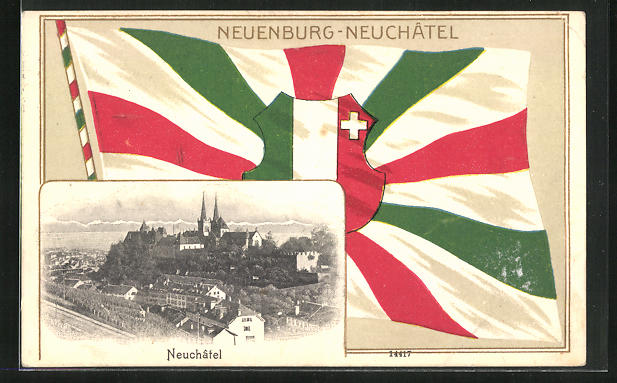![[Colour Flag NE]](../images/c/ch-ne_col.jpg) image
located by Martin Karner
image
located by Martin Karner
Last modified: 2024-04-27 by martin karner
Keywords: neuchâtel | prussia | napoleon | french |
Links: FOTW homepage |
search |
disclaimer and copyright |
write us |
mirrors
![[Flag of Neuchâtel]](../images/c/ch-ne.gif) image by T.F. Mills/António Martins
image by T.F. Mills/António Martins
Description of the flag
Tierced per pale vert, argent and gules, in sinister chief a cross
couped silver.
Divided vertically into three equal parts green, white and red. In
the top corner of the fly is a small white Confederate Cross. The
cross is the old Confederate style with long, narrow arms, and not
the modern federal one with shorter, stubbier arms.
T.F. Mills, 4 November 1997
Symbolism of the flag
There are two theories about the symbolism of the Neuchâtel colours,
and they are not necessarily mutually exclusive. The current
cantonal flag was first adopted in the mid-19th century by the
republican and revolutionary party. Their flag was either
unimaginatively taken directly from the Italian republican and independentist movement, or the colours represented revolution (green
and white) and allegiance to Switzerland (red with white cross).
T.F. Mills, 4 November 1997
The colors are based upon the national colors of the herald of Neuchâtel,
green and white the colors of rebellion and red and white, the colors of the
Swiss flag. The cross was added in 1870 to distinguish the flag from the Italian
flag. The flag of 1350 (or, on a pale gules, three chevronels argent) was
discarded in 1848, but there have been three unsuccessful plebicites to
reintroduce this flag (1921, 1931, 1954).
Source: Angst (1992), "A Panoply of
Colours: The Cantonal Banners of Switzerland and the Swiss National Flag"
Phil Nelson, 14 October 1998
Today, I read in the newspaper some definitions of the colours one can find on the
francophone Swiss cantons' flags. The sources are quite sure (Mr. Maurice de Tribolet,
who looks after the records of the Republic and Canton of Neuchâtel, and the article was in the
newspaper "Le Temps" of 4 January 2001, the biggest francophone Swiss newspaper). The flag had to be created
after the "Revolution of the 1st March 1848" and the Republicans had no time to try to find a new state
flag. They decided the "red" would stand for the south of the Canton because that is a great region for
wine production, the "white" would stand for the valleys and their "white walls" and the "green" would
stand for pastures and forests in the north of the Canton.
Nasha Gagnebin, 4 January 2001
I was interested to learn that the predominant colors in the Neuchâtel
arms were red and yellow. This explains why the infantry of Berthier's
Neuchâtel Battalion (which fought for Napoleon in Spain, Russia, Germany
and France) wore yellow "Spencer" coats with red collar, cuffs,
turnbacks and lapels – a most colorful and unusual uniform, even by the
gaudy standards of the Grand Army.
Tom Gregg, 3 February 1997
[Seal (1344–1370) of Count Louis of Neuchâtel, the knight's shield showing already the changed
arms, followed by the flag in 1350 (source). –
Battalion flag, presented in 1819 from crown prince Wilhelm IV of
Prussia to the troops (Neuchâtel was simultaneously a Prussian principality and a Swiss canton from
1815 to 1848). The escutcheon in the center of the flag shows the arms of the Prussian house Châlons-Orange, of Neuchâtel
and the Prussian eagle. It is framed by a branch of oak leaves and a branch of laurel leaves, both in green (source: [ges43]).
See photo of this and other flags on a postcard (Château de Colombier, salle des drapeaux). –
New cantonal flag (1848, the year date printed with black ink),
one of the first new flags. Location: Musée militaire et des toiles peintes, Colombier NE
(source)]
![[Neuchâtel flag of 1350]](../images/c/ch-ne-18.gif) image by António Martins
image by António Martins
![[Neuchâtel flag of 1836-1848]](../images/c/ch-ne700.gif) image by ND
image by ND
![[Colour Flag NE]](../images/c/ch-ne_col.jpg) image
located by Martin Karner
image
located by Martin Karner
Rectangular cantonal flag, as shown in Mader (1942) (So-called
colour flag [Farbenfahne in German].
As a special case the colour flag of Neuchâtel keeps the design of the regular flag).
Martin Karner
Flaggen, Knatterfahnen and Livery Colours |
![[Knatterfahnen]](../images/c/ch-ne_kf.gif)
|
Flaggen are vertically hoisted from a crossbar in the manner of gonfanon, in ratio of about 2:9, with a swallowtail that indents about 2 units. The chief, or hoist (square part) usually incorporates the design from the coat of arms – not from the flag. The fly part is always divided lengthwise, usually in a bicolour, triband or tricolour pattern (except Schwyz which is monocolour, and Glarus which has four stripes of unequal width). The colours chosen for the fly end are usually the main colours of the coat of arms, but the choice is not always straight forward.
Knatterfahnen are similar to Flaggen, but hoisted from the long side and have no swallow tail. They normally show the national, cantonal or communal flag in their chiefs.
Željko Heimer, 16 July 2000
The little cross of the flag has been kept on the livery colours of Neuchâtel canton to avoid confusion with an
Italian banner.
Pascal Gross, 22 April 2001

 images located by Martin Karner
images located by Martin KarnerAt the beginning of the 20th century, flamed flags were still in use, with the white cross replaced by
a (baroque) shield in the centre of the flag. These decorative flags had been used until WWII and then
somewhat forgotten in preference of the current cantonal flags. [Today they are being
produced again, see right image]
Pascal Gross, 30 June 2002
See also: - Other examples of "Early 20th century flag design":
CH, AG, AI,
AR, BE, BL,
BS, FR, GE,
GL, GR, JU,
LU, NW, OW,
SG, SH, SO,
SZ, TG, TI,
UR, VD, VS,
ZG, ZH
- Modern flamed flags